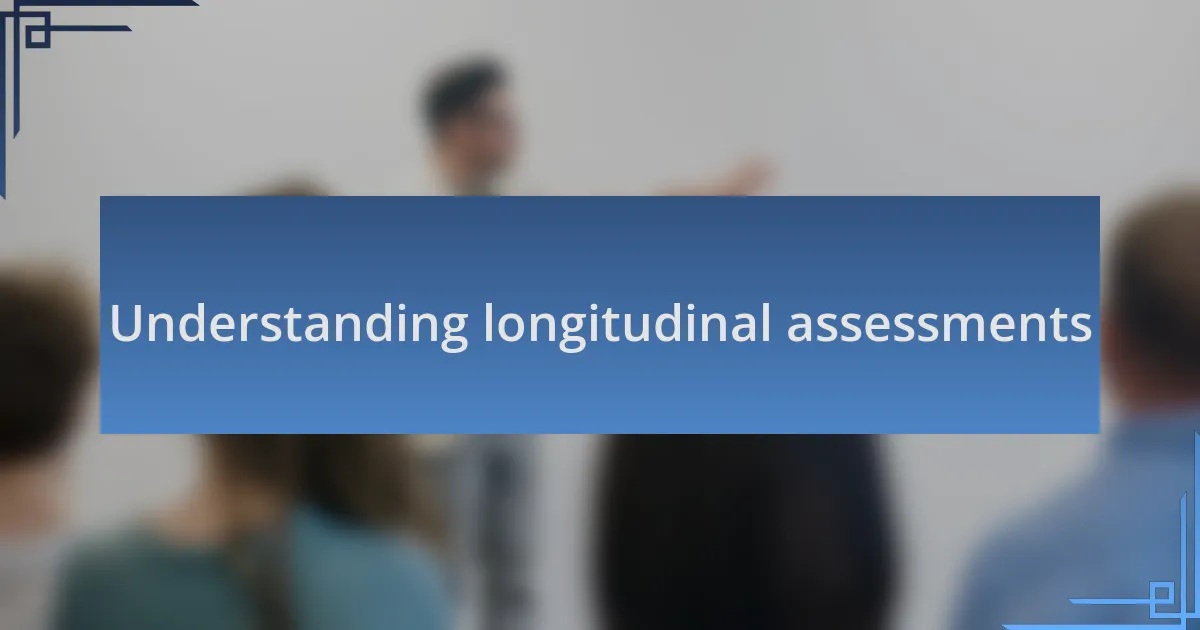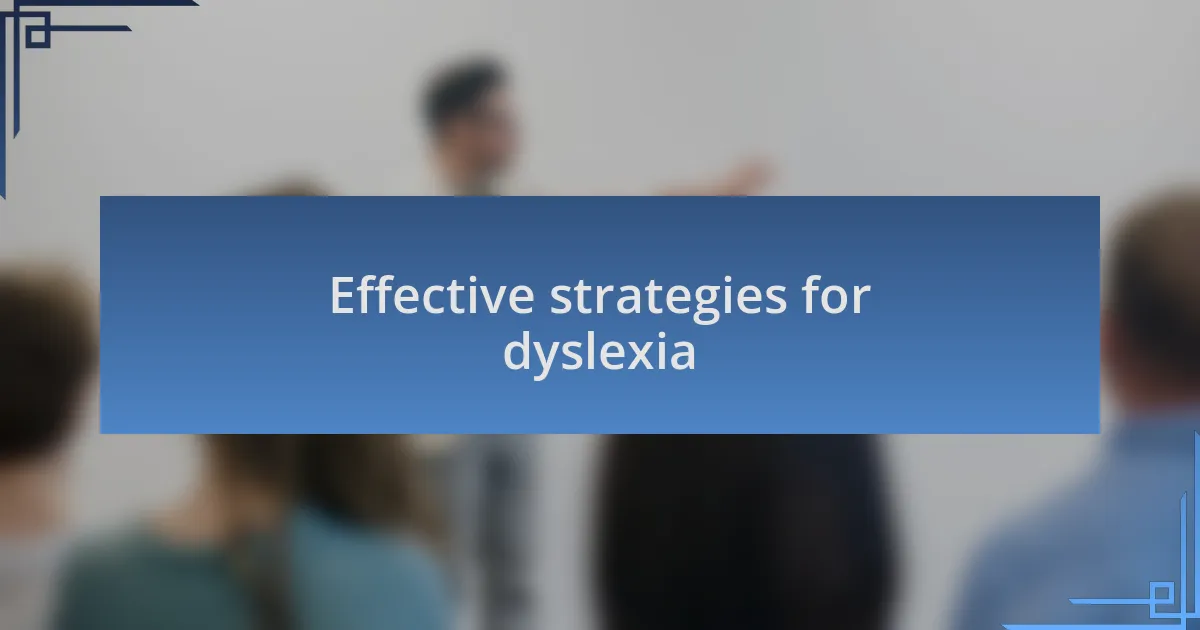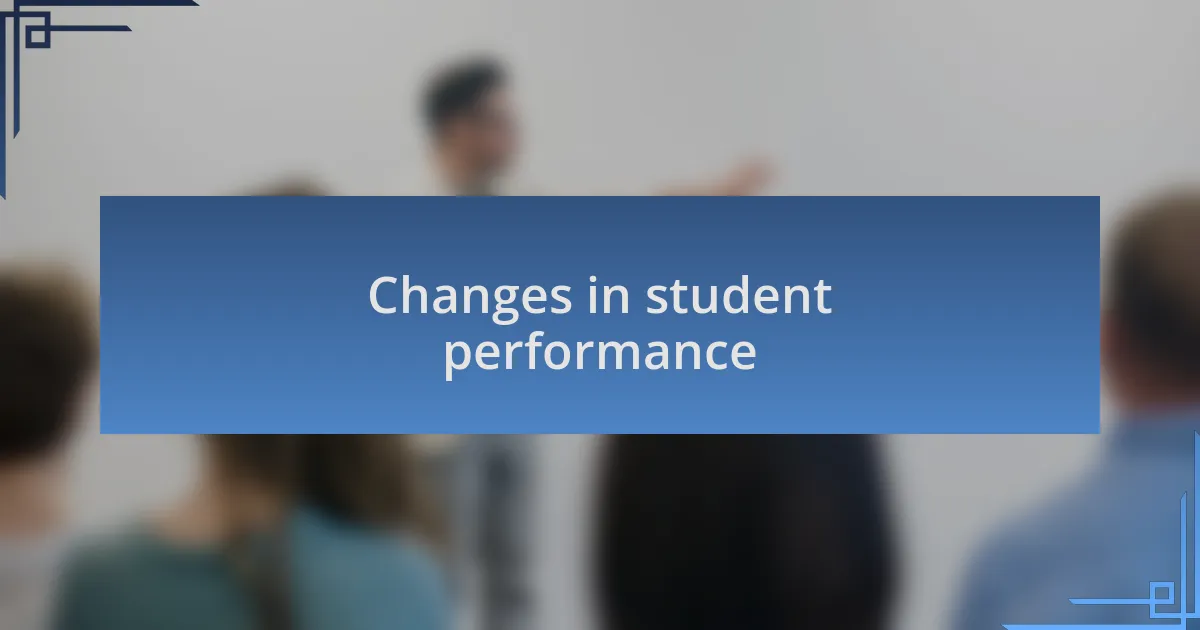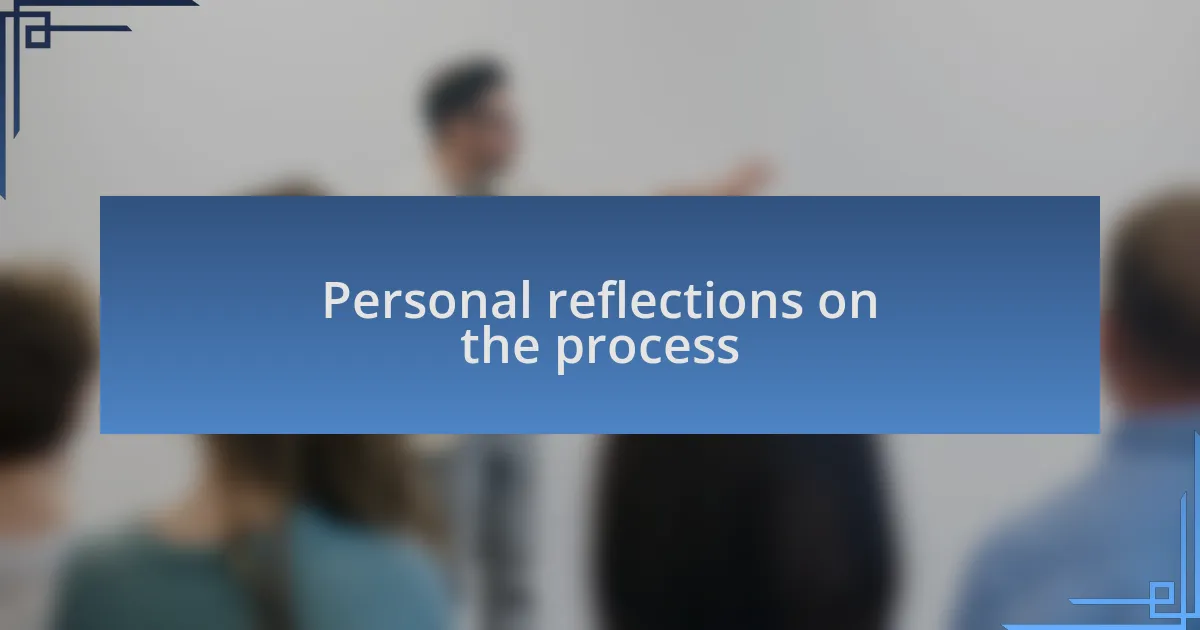Key takeaways:
- Longitudinal assessments effectively track student progress over time, revealing growth and patterns often missed in shorter evaluations.
- Dyslexia training focuses on tailored strategies and creating an inclusive environment, fostering confidence and community among learners.
- Individualized learning plans and early interventions significantly enhance long-term academic success and emotional resilience in students.
- Future training could benefit from ongoing feedback loops and emotional support integration, promoting holistic development in learners.

Understanding longitudinal assessments
Longitudinal assessments are fascinating tools for tracking progress over time, especially in the context of learning differences, like dyslexia. I remember the first time I engaged with a longitudinal study; it felt like peering into a time capsule of growth. Have you ever observed changes in yourself or a loved one that made you rethink earlier judgments? This kind of assessment captures those moments.
What sets longitudinal assessments apart is their ability to unveil patterns that might remain hidden in shorter evaluations. For instance, I once worked with a student whose reading abilities were stagnant in the short term, but over the course of a year, there was a remarkable transformation. Observing this shift made me realize how critical it is to remain patient and open-minded during the learning journey.
Moreover, these assessments offer invaluable insights into the effectiveness of various teaching methods. Reflecting on my own experiences, I can’t help but wonder how differently my early learning might have shaped up with consistent assessments that identified my challenges in real time. Isn’t it intriguing to think about how understanding these nuances can lead us to better strategies and ultimately, better outcomes?

Importance of dyslexia training
Dyslexia training is crucial because it equips individuals with tailored strategies to navigate their unique learning landscapes. I once encountered a young learner who struggled immensely with phonemic awareness, a core skill for reading. Through targeted training, we unlocked not just strategies for literacy, but also a newfound confidence in her abilities. Can you imagine the difference this made in her daily life?
What truly resonates with me about dyslexia training is the focus on creating an inclusive learning environment. I vividly remember facilitating a workshop where parents shared their experiences. Their stories underscored the profound impact of effective training programs—transforming frustration into empowerment. Isn’t it inspiring how knowledge can shift the narrative for individuals with dyslexia and their families?
Moreover, dyslexia training fosters a sense of community among learners, educators, and families. Participating in group sessions often leads to invaluable peer support, which I found incredibly uplifting while working with fellow educators. Have you ever felt the strength of a shared journey? The camaraderie built through these programs not only enhances learning but also cultivates resilience and hope for everyone involved.

Key findings from assessments
One of the most striking findings from longitudinal assessments is the significant strides students make in reading fluency over time. I recall working with a student who, at the beginning of the year, struggled to read simple sentences. After consistent training and support, by the end of the year, he was confidently tackling chapter books. It’s remarkable to witness such a transformation; it left me wondering how many more lives could be changed with similar efforts.
Another key takeaway is that early intervention plays a critical role in long-term success. I once collaborated with a team that tracked the progress of students who received training at a young age. Their gains in vocabulary and comprehension were not only impressive but also provided a strong foundation for their continued academic journey. This experience led me to ponder: how can we ensure that these young learners get the support they deserve as early as possible?
Finally, assessments revealed how vital individualized learning plans are for each student. During a workshop, I met a teacher who tailored her approach based on her students’ unique challenges and strengths. This personalization not only improved their academic outcomes but also fostered a sense of belonging in the classroom. Reflecting on this, I can’t help but ask, how can we encourage more educators to embrace such adaptable strategies in their teaching?

Effective strategies for dyslexia
Effective strategies for dyslexia can make a profound difference in a student’s learning experience. I remember guiding a student who found comfort in multisensory learning techniques. By incorporating visual aids, tactile materials, and auditory resources, she gradually began to enjoy reading. Watching her smile as she recognized words she once struggled with was incredibly rewarding—it made me question how many more students could thrive if we embraced these multisensory approaches consistently.
Another strategy that I found impactful is the use of structured literacy programs. I once attended a training session where the instructor demonstrated how systematic phonics instruction helped students decode words more effectively. As I implemented these methods in my classroom, I noticed a student who previously felt overwhelmed by complex texts become more confident and willing to participate in group discussions. This transformation made me reflect on the importance of teaching foundational skills—how can we help others see that effective literacy instruction can be both structured and engaging?
Finally, fostering a supportive learning environment cannot be overlooked. There was a time when I observed a classroom that thrived on encouragement and understanding. Teachers celebrated every small victory, which significantly boosted the students’ self-esteem. This experience taught me that emotional support and patience are just as crucial as academic strategies. How might our teaching practices change if we prioritize emotional well-being alongside academic achievement?

Changes in student performance
As I tracked the progress of my students through longitudinal assessments, I was struck by the noticeable shifts in their performance over time. One student, who had once labored over simple texts, began to approach reading with newfound enthusiasm and ease. It was fascinating to see how consistent engagement with tailored support could lead to such significant changes.
I remember a particularly enlightening moment with a student who had initially struggled to complete assignments. After several months of focused interventions, he aced a challenging reading comprehension task. The look of disbelief mixed with joy on his face was something I will never forget. It reminded me that our perceptions of students’ potential often evolve when we actively monitor their growth—how often do we overlook the small victories that pave the way for larger successes?
Longitudinal assessments also illuminated patterns in student performance that surprised me. For example, students who participated in group learning activities showed not only improved reading skills but also better collaboration in their interactions with peers. This raised an interesting question for me: how can we further leverage social learning to enhance academic performance in students with dyslexia? Each assessment cycle brought insights that encouraged me to rethink my approach continuously.

Personal reflections on the process
As I reflect on the process, I can’t help but think about the emotional connection I developed with my students. I vividly remember one particular student, Sara, who initially shied away from reading aloud. After several months of regular assessments, I noticed her confidence blooming. The pride on her face as she read a paragraph correctly without any hesitation left me feeling elated. It was a powerful reminder of how self-esteem plays a crucial role in learning.
Engaging with students through longitudinal assessments often felt like piecing together a complex puzzle. Each data point provided clarity, yet there were moments of uncertainty that challenged my strategies. I recall a student named Alex who progressed academically, but his emotional journey was equally essential. He would often express frustration and doubt. Understanding the emotional landscape behind the data spurred me to support not just the skills but also the mindset necessary for success. How often do we allow ourselves to feel the weight of these emotions in educational assessments?
These experiences compelled me to ask deeper questions about the process. What if we not only measured academic growth but also tracked emotional resilience over time? I believe that blending these insights could lead to a more holistic understanding of our students’ journeys. The growth I’ve witnessed has not just been about grades; it’s about nurturing a love for learning. In the end, it’s those human connections that have enriched my teaching experience more than any statistic could ever reflect.

Future applications in training
The future of training in dyslexia interventions holds a world of possibilities. Imagine incorporating continuous feedback loops based on longitudinal assessments to tailor strategies for each student. I once encountered a student, Jamal, whose learning style didn’t click with traditional methods. Through ongoing evaluations, I realized he thrived when engaged in multi-sensory activities. If we can harness these insights in future training, we might unlock each student’s unique potential earlier in their journey.
I’ll never forget working with Emily, who had been reluctant to embrace her strengths due to previous challenges. Longitudinal assessments revealed her incremental progress in phonemic awareness over time, but what struck me was how she began to articulate her feelings during our sessions. This experience taught me that integrating emotional support into training programs can profoundly impact outcomes. Could regular check-ins about emotional well-being alongside academic goals be the game-changer we’ve been waiting for?
Additionally, the data we’ve collected through assessments can inform not only individual student plans but also group training approaches. Picture a scenario where educators collaborate based on shared insights from their assessments. I feel there’s a real opportunity to foster a community of practice among teachers. By sharing successes and strategies, we would create a network of support that can elevate our training efforts. What if we encouraged this type of collaboration more actively—wouldn’t it enhance the overall learning experience for everyone involved?